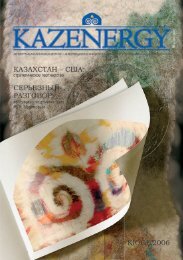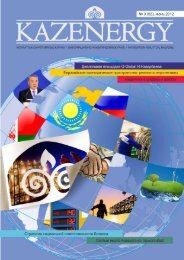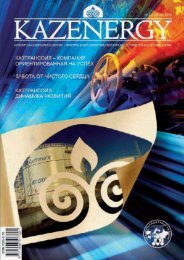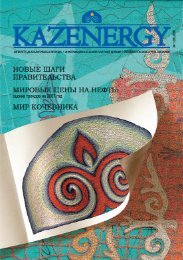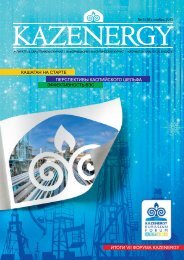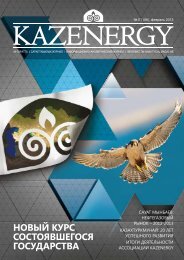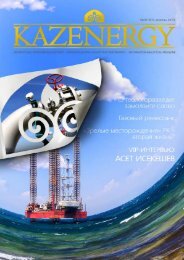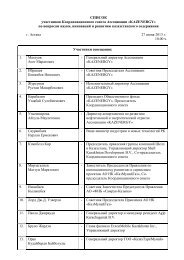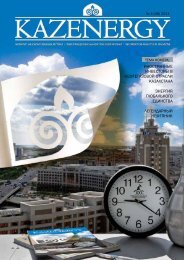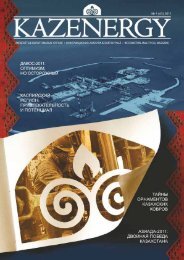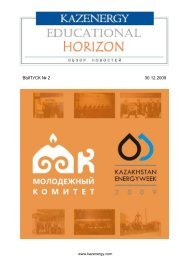â 5 (49), 2011 - KazEnergy
â 5 (49), 2011 - KazEnergy
â 5 (49), 2011 - KazEnergy
- No tags were found...
You also want an ePaper? Increase the reach of your titles
YUMPU automatically turns print PDFs into web optimized ePapers that Google loves.
azakhstan sector of theCaspian Sea (KSCS) hasthe largest hydrocarbon reservesin comparison withother Caspian littoral countries.Кby Energy In the foreseeable futureFocus oil extraction on the shelfwill not only significantlyincrease oil production inthe country, but also strengthen the positionof Kazakhstan as an important supplier ofhydrocarbons to world markets. So, Caspianoil of Kazakhstan for some extent will be aneffective alternative for resources of politicallyunstable Middle East region and willhelp to compensate the effects of drop in productionin other major oil and gas centers ofthe world.Although certain works on the KSCS wereconducted before the republic gained its independence,the start year of the full studyand development of potential is 1993. Thenthere was formed the international consortium"Kazakhstancaspishelf", whose workhas proved to the world community a hugehydrocarbon potential of the KSCS.For example, during the years of independence,it was revealed more than 120 prospectivestructures on it with forecast reservesof 8 billion tons of equivalent fuel,including 4.5 billion tons of oil.It should be noted that the area of KSCS,proceeding from the geological conditions ofthe subsurface structure and other terms ofthe development of water area, is divided intothree zones, which are characterized by variousoil and gas potential, the conditions ofexploration and extraction of raw materials.In particular, in Zone 1 subsalt Upper Paleozoicdeposits are the main ones by expectedpromising resources.The big and the biggest oil and gas fieldswere discovered in this zone from 2000 to2004 - Kashagan, Aktoty, Kairan, now settlingdown in the framework of the NorthCaspian project. By the way, after the openingof Prudhoe Bay field in Alaska at the endof 1960, Kashagan is one of the largest oilfields in the world with recoverable hydrocarbonreserves of more than 10 billion barrels.In Zone 2, consisting of Kalamkas-sea, Auezovand Khazar sections, the Mesozoic complex ofrocks is considered as perspective. For thecurrent, date the industrial productivity ofMiddle Jurassic deposits here is confirmed.In zone 3, which includes parts of Rakushechnoyesea and Nursultan (N Block), Mesozoiccomplex is promising. Designated areas arealso distinguished by depth of water, ice andenvironmental conditions.Recall that according to the plan of developmentof the Kashagan field with geologicalreserves of 4.85 billion tons in 2010-11 it isprovided a conduction of exploration phase,as for 2012-20 years - industrial development.Exploration on Kayran will be heldbefore 2015, on Aktoty and Kalamkas-sea -up to 2017, on Khazar - to 2018, on Auezov- until 2019. On the site of Rakushechnoyesea a search phase will be completed in <strong>2011</strong>,on the N block - in <strong>2011</strong>-12, and explorationhere will be held respectively in 2012-19 and2013-19 years. The exploration period willbe followed by industrial exploitation of oilfields. Also in the near future, Kazakhstanwill begin exploration on the Abay block, later- on the Khvalynskoye and Central blocks.However, now, on results of seismic and geologicalprospecting, oil and gas potential wasproved on Khazar, Auezov and Rakushechnoyesea structures.Kazakhstan has been actively developingthe exploration and further production ofhydrocarbons on the Caspian shelf in partnershipwith interested foreign investors.Now the Caspian projects are representedby such leading oil and gas companies of theworld as ExxonMobil, ConocoPhillips, Shell,Total, Eni, LUKoil, ONGC and others. In recentyears, foreign investors have investedto the development of offshore fields in ourcountry tens of billions of dollars. For example,investments only to Kashagan weremore than $ 33 billion, the bulk of whichgoes for capital investments of foreign participantsof the North-Caspian project.Partnership with them has enabled the countryto get considerable experience in conductionof offshore oil operations and even todayto serve as a co-operator of offshore projects.At the same time, the country has all the potentialfor self-implementation of large offshoreprojects. The country has enough forfinances and resources, as well as technologicalcapabilities. In the future this tendencywill only intensify. Accordingly, a strategy forfuture cooperation in the implementation ofprojects in the KSCS is being formed: it mustbe based on equal partnership, with the gradualstrengthening of the role of Kazakhstan.Production potential. The Kashagan, Kairanand Aktoty fields have the bulk of thetotal hydrocarbon production from KSCS inthe longer term.In 2012 it is planned to produce 568 thousandtons of oil and gas condensate in totalfor KSCS, in 2013 – 9 124 tons, in 2014 - 13237 thousand tons, in 2015 - 14 900 thousandtons, in 2016 - 28 930 tons, in 2020 -65 225 tons. Until 2017 inclusive, the entirevolume of oil production will occur in zone1, while in 2018 - 41 870 thousand tons, andin 2020 - 61 877 thousand m. In this caseprior to 2015 will remain the sole KashaganKAZENERGY61




